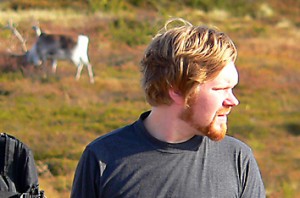Mlab DA seminar Thu 12 May in room 429, Miestentie 3B, 5-7pm:
Heidi Hirsto
Yrjö Tuunanen: Panoramic News Narration – Constructive financial discourse skills for the news media and critical media audience
Pirkka Åman: Musical Serendipity – Designing Contextual Music Recommendation and Discovery
Welcome!
 Heidi Hirsto, DSc(Econ), is post-doctoral researcher at Aalto University School of Business, Department of Management Studies, Unit of Organizational Communication. Her research interests lie in critical, discursive, and cultural approaches to organizational phenomena and business-society relations, and in the workings of economic rhetoric in different genres and social contexts. Her current research focuses on the role of emotion discourse in institutional work, and on mediated practices of economic citizenship in online environments. Her work has appeared in several edited books as well as scholarly publications, including Organization Studies; Consumption, Markets & Culture; and Equality, Diversity and Inclusion: An International Journal. She is currently visiting at Vienna University of Economics and Business, Institute for Organization Studies.
Heidi Hirsto, DSc(Econ), is post-doctoral researcher at Aalto University School of Business, Department of Management Studies, Unit of Organizational Communication. Her research interests lie in critical, discursive, and cultural approaches to organizational phenomena and business-society relations, and in the workings of economic rhetoric in different genres and social contexts. Her current research focuses on the role of emotion discourse in institutional work, and on mediated practices of economic citizenship in online environments. Her work has appeared in several edited books as well as scholarly publications, including Organization Studies; Consumption, Markets & Culture; and Equality, Diversity and Inclusion: An International Journal. She is currently visiting at Vienna University of Economics and Business, Institute for Organization Studies.
 Yrjö Tuunanen: Panoramic News Narration – Constructive financial discourse skills for the news media and critical media audience
Yrjö Tuunanen: Panoramic News Narration – Constructive financial discourse skills for the news media and critical media audience
This dissertation focuses on further developing financial news discourse skills of media audience as well as media professionals by researching narrative structures and elements within multimodal news dissemination online. This study maps and analyzes existing practices of multimodal financial news discourse, guided by the main research question: What kinds of narrative features and capacities are there in the digital domain for extending financial discourse skills for the news media and for the critical media audience? In other words, the study aims to identify and develop constructive narrative practices and multimodal solutions to be applied for financial news dissemination, as well as develop skills and tools for critical financial news literacy.
The research questions related to the research material, audiovisual news narratives on Greek debt crisis in the mainstream media, are: How do the narrative structures and elements of the video reports and captioned stock photo slide shows create meanings of and facilitate civic voice and participation in financial discourses? How do the episodic and thematic approaches (Iyengar, 1991) and narrative components of the news texts reinforce or challenge the mainstream discursive coherence and the simplified binary constructions in the Greek debt crisis talk, and where and how do the citizens as characters stand in these settings? Through these more concrete secondary questions, the thesis answers the main research question, and identifies applicable, constructive narrative practices and multimodal solutions for financial news dissemination as well as develop knowledge and skills for critical financial news literacy.
The research builds on the literature on narration (Abbott 2008; Herman 2007; Ryan, 2007, 2014), journalism and media studies (Baudrillard 1994; Bock 2012; Broersma 2010; Chouliaraki 2008; de Goede 2015; Jones 2009; Johnson-Cartee 2005, Karlsson 2010; Kovach and Rosenthiel 2014; Schudson 2001; Stephens 2014) and theories of multimodality and multimodal narration (Matthiessen 2006; O ́Halloran 2006, 2008, 2011; Page 2010). Moreover, the thesis draws on sociological (Somers & Gibson 1994) and psychological (Bruner 1986, 1990, 1991) perspectives on narrative, Iyengar ́s (1991) notions on episodic and thematic framing of news texts, and the literature on civic voice and participation (Couldry 2010; Dahlgren, 2000, 2011). Building on this theoretical framework, the study suggests a set of narrative features and principles for advancing narrative transparency and “panoramic”, financial news reporting, as well as constructive news discourse skills in the web-based media.
The outcome of the thesis is twofold. It creates new knowledge on emerging practices for digital journalism, contributing to theoretical discourses on online journalism and media studies. Second, it develops and suggests concrete, innovative news text types, genres and narrative structures for online news media, aiming for further developing comprehensive and perceptive news narration and critical financial news discourse skills of the news audience.
Keywords: Financial news discourse skills, economic citizenship, online news media, multimodality, constructive news narratives, narrative transparency, panoramic news narration.
References:
Abbott, H. Porter 2008. Cambridge Introduction to Narrative. Cambridge University Press.
Baudrillard, Jean 1994. Simulacra and Simulation, The University of Michigan. Bock, Mary A. 2012. Newspaper journalism and video: Motion, sound, and new narratives», New Media & Society, 14(4): 600-616.
Broersma, Marcel 2010. The Unbearable Limitations of Journalism – On Press Critique and Journalism’s Claim to Truth. The International Communication Gazette, 1748-0485; Vol. 72(1): 21–33.
Bruner, Jerome 1986. Actual Minds, Possible Worlds. Harvard University Press, Boston
Bruner, Jerome 1990. Acts of Meaning, Harward University Press, Boston.
Bruner, Jerome 1991. The Narrative Construction of Reality. Critical Inquiry, vol 18, no 1 pp. 1-21.
Chouliaraki, Lilie 2008. The media as moral education: Mediation and action. Media, Culture & Society, 30(6), 831-852.
Couldry, Nick 2010. Why Voice Matters, Culture and Politics After Neoliberalism. Sage.
Dahlgren, Peter 2000. The Internet and the Democratization of Civic Culture, Political Communication, 17:4, 335-340.
Dahlgren, Peter 2011. Young Citizens and Political Participation: Online Media and Civic Cultures. Taiwan Journal of Democracy, 7(2): 11-25.
de Goede, Marieke 2015. Documenting financial assemblances and the visualization of responsibility. In Rens Van Munster & Casper Sylvest (eds) Documenting World Politics: A Critical Companion to IR and Non-Fiction Film. Routledge. 58-77.
Herman, David (ed) 2007. The Cambridge Companion to Narrative. Cambridge University Press.
Iyengar, Shanto 1991. Is Anyone Responsible? University of Chicago Press.
Johnson-Cartee, Karen S. 2005. News Narratives and News Framing: Constructing Political Reality. Series: Communication, Media, and Politics.. Lanham, MD: Rowman & Littlefield Publishers, Inc.
Jones, Alex S. 2009. Losing the News: The Future of the News that Feeds democracy. Oxford University, Oxford/New York.
Karlsson, Michael 2010. Rituals of Transparency. Journalism Studies 11(4), pp. 535- 45.
Kovach, Bill and Tom Rosenstiel 2014. The Elements of Journalism: What Newspeople Should Know and the Public Should Expect. Three Rivers Press.
Matthiessen, Christian 2006. The multimodal page: a systemic functional exploration. In Bowcher Wendy and Terry Royce (eds.), New Directions in Multimodal Discourse Analysis. Hillsdale, NJ: Lawrence Erlbaum Associates, 1-62.
O’Halloran, Kay L. 2011. Multimodal Discourse Analysis. In Hyland, Ken, and Brian Paltridge (eds.). Continuum Companion to Discourse. London; New York. Continuum. 120-137.
O’Halloran, Kay L. 2006. Multimodal Discourse Analysis: Systemic-Functional Perspectives. Continuum.
O’Halloran, Kay L. 2008. Systemic functional-multimodal discourse analysis (SF- MDA): constructing ideational meaning using language and visual imagery. Visual Communication 2008/7. Sage 7(4): 443–475.
Page Ruth (ed) 2010. Perspectives on Narrative and Multimodality, Routledge.
Ryan, Marie-Laure 2014. Narration in Various Media. In Hühn, Peter et al. (eds.) The Living Handbook of Narratology. Hamburg: Hamburg University. URL = http://www.lhn.uni-hamburg.de/article/narration-various-media
Ryan, Marie-Laure 2007. Toward a Definition of Narrative. In D. Herman (ed). The Cambridge Companion to Narrative. Cambridge: Cambridge UP, 22–35.
Schudson Michael 2001. The Objectivity Norm in American Journalism. Journalism: Theory, Practice and Criticism 2(2), pp. 149-70.
Somers, Margaret R. and Gloria D. Gibson 1994. ‘Reclaiming the Epistemological “Other”: Narrative and the Social Constitution of Identity’, in Craig Calhoun (ed) Social Theory and the Politics of Identity, Oxford UK & Cambridge USA: Blackwell, 37-99.
Stephens, Mitchell 2014. Beyond news: the future of journalism. New York Columbia University Press.
Musical Serendipity – Designing Contextual Music Recommendation and Discovery
During the last decade, the promises of networked digital media have started to realize. Time and location independent production, distribution and consumption of media content, together with social media participation are now reality for everyone with a computing device and an Internet connection. This socio-technological revolution has also made possible highly personalized and context-aware media services. My thesis focuses on designing and researching interactions that aim to provide new kinds of user experiences for contextual music recommendation and discovery through service concepts and prototypes.
The main research objective is how to design enjoyable and rewarding music recommendation and discovery services that utilize contextual information from the interaction point of view? The underlying assumption of the study is that contextual information does matter and it is important to take this information into account when designing user experiences for music discovery and recommendation.
One of the key concepts of the work is personalization, i.e. tailoring media content according to user’s preferences. Recommendation systems are a form of personalization, implemented in applications such as online dating and travel systems either by gathering information from the user automatically, or by user input. Another key concept, serendipity, i.e. making positive discoveries by chance is often enabled by well-designed recommendation services adopting personalization techniques. By music interactions I refer to the human-technology interactions with recorded music content.
The concept of context refers to a certain frame within which something exists or happens. The importance of the concept is highlighted by the ability of modern mobile phones to adapt to and offer services tailored for the user situation. Location-awareness, achieved by global positioning system (GPS), wireless local area networks (WLAN), or radio signal measurement plays an important role in context-aware computing since it enables an accurate geographical positioning of mobile devices and their users. Indeed, positioning technologies embedded in the modern mobile devices enabled the first context-aware computing applications. Ubiquitous media can be used everywhere; the term became widespread with the adoption of mobile media and communication devices.
The main motivation for developing and researching contextual music interactions stems from the fact that people have a wide variety of psychological and social uses and functions for music across a wide variety of situations. Given that people listen to different music in different situations lays a foundation for the argument that context factors really matter in designing interactive music services.
With ubiquitous streaming services such as YouTube and Spotify, we have entered an era of second generation of digital music services where music tracks do not need to be downloaded but they can be consumed as a stream over the Internet. In most music consumption situations, physical discs or local music files are no longer needed. Today, when music is a truly ubiquitous commodity, it can be listened to in almost any situation, increasingly stressing the importance of context factors.

